Joe Petagno Art of Elvis Epereguspat7 Tm Off
The very best of rock music is fine art and passion. It won't be wrong to say that stone music has produced some of the most exciting, creative and innovative album art in the history of music. Many prominent visual artists – such equally Andy Warhol, Mike Kelley, Tibor Kalman, Raymond Pettibon, Gerhard Richter, and Slater Bradley – come up to mind if nosotros talk about some of the most notable contributions to the fine art side of the genre.
Today's article is by no means extensive, just it celebrates some of the finest stone album covers and their creators. Scroll through the gallery to see which one catches the most attention and learn how they were conceptualized and designed.
if you're looking for some album cover color inspiration, check out this post, and only considering they're crawly, here are some archetype albums recreated with Lego.
Don't forget to share your thoughts in the comments section below!
Aladdin Sane (David Bowie)
Aladdin Sane album cover, based on British photographer Brian Duffy'south portrait, features Ziggy Stardust in glam-inspired make-up. I of its about distinctive features is the exuberant lightning bolt over one eye and a mysterious teardrop dripping from the clavicle. Often called "The Mona Lisa of Pop," the encompass is inarguably one of the most iconic images in pop art history.

Appetite for Destruction (Guns N' Roses)
The original artwork for Appetite For Devastation consisted of a robotic rapist based on a Robert Williams painting. Afterward several complaints from music retailers, the band replaced it with an image depicting a cross and skulls of the five band members.
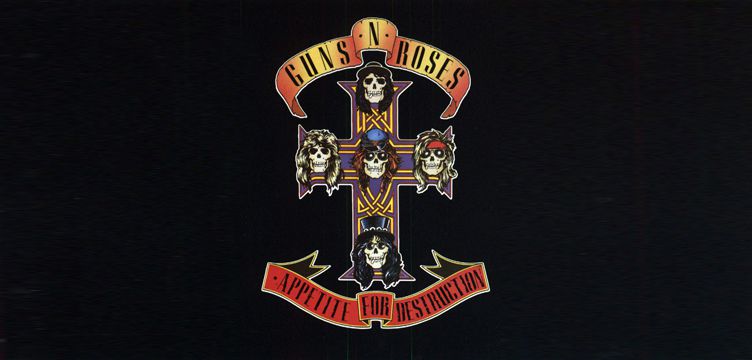
Bold as Love (Jimi Hendrix Experience)
The embrace art for Bold every bit Love features a painting of Jimi Hendrix, Noel Redding and Mitch Mitchell superimposed over a Hindu-art influenced painting drawn by Roger Law. The actual photo-portrait was taken past Karl Ferris and "Viraat Purushan-Vishnuroopam," a depiction of the Hindu god Vishnu or Krishna, served equally inspiration for this archetype album comprehend.
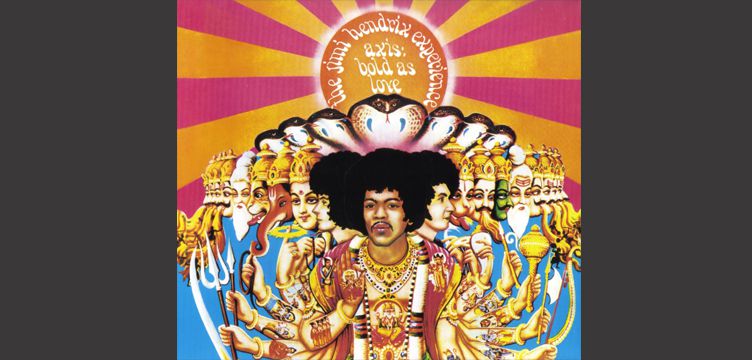
Born to Run (Bruce Springsteen)
The Built-in to Run artwork is based on a photograph taken by Eric Meola. According to Bruce Springsteen biographers, Meola shot 900 frames in a single session spanning 3 hours and the photo they finally selected (pictured to a higher place) shows Springsteen holding a Fender Telecaster guitar with an Esquire neck in his left hand, while putting his right paw on the shoulder of saxophonist and fellow bandmate Clarence Clemons.
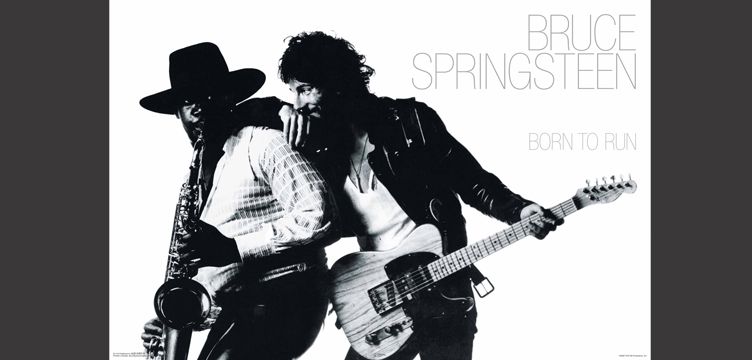
Brain Salad Surgery (Emerson, Lake & Palmer)
This meticulously-designed album embrace was created by renowned Swiss painter and designer, H. R. Giger. Giger was asked past the band's Swiss agent to create a cover for an anthology originally titled "Whip Some Skull on You".
The album sleeve featured monochromatic biomechanical artwork, incorporating an industrial mechanism with a human female skull modeled subsequently his wife, Li Tobler, too as a new ELP wordmark. The lower department of the skull's confront bears a circular screen which shows the mouth and lower face in its mankind-covered normal state.
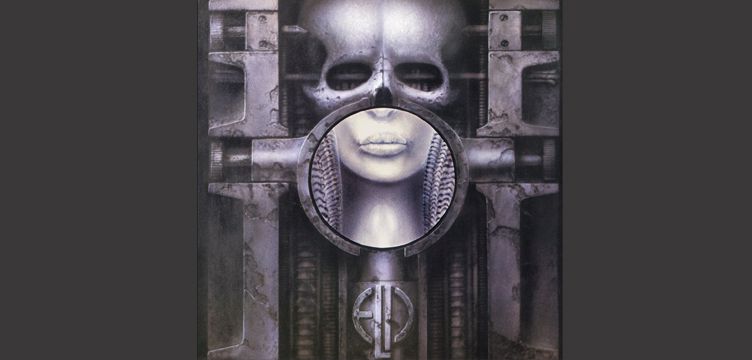
Bringing Information technology All Back Home (Bob Dylan)
The cover art of Bringing It All Back Habitation, Bob Dylan's first electrical anthology,was based on a photography taken past Daniel Kramer with an edge-softened lens. It shows Dylan sitting on a couch with various artifacts scattered effectually the room, including a Time mag with President Lyndon B. Johnson on the cover and LPs by his favorite artists such as The Impressions, Robert Johnson, Ravi Shankar, Lotte Lenya, Eric Von Schmidt, and Lord Buckley.
The photo also features Emerge Grossman, wife of his manager Albert Grossman, reclining on a chaise lounge chair while the edges blur in a circle.
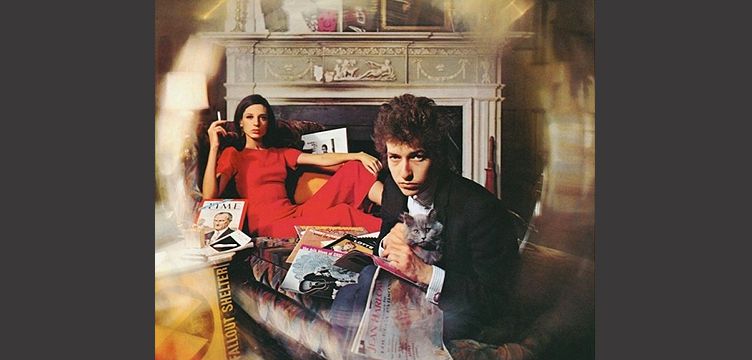
Disraeli Gears (Cream)
Disraeli Gears artwork was designed by Australian creative person, songwriter and filmmaker Martin Sharp. The psychedelic collage surrounded past a floral organisation is actually based on a photography taken past famous British photographer Robert Whitaker, who also worked for The Beatles.

Hotel California (The Eagles)
This anthology encompass is probably 1 of the most controversial, yet fascinating, artworks in the history of rock music. Information technology is based on a David Alexander photo which features the Beverly Hills Hotel, likewise known as the Pink Palace.
English graphic artist John Kosh is credited with its design and art management. The artwork has aroused much controversy over the years due to its alleged links with the Church of Satan.
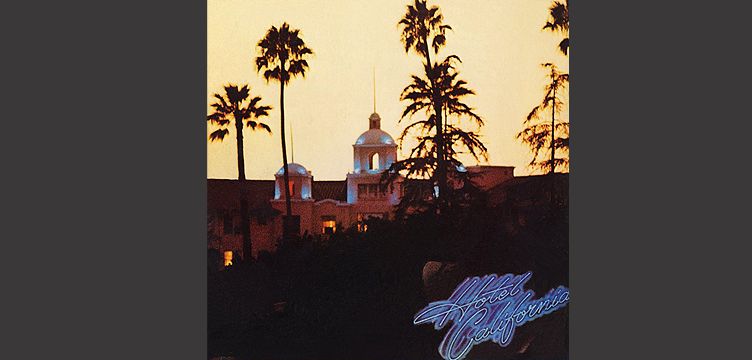
Houses of the Holy (Led Zeppelin)
This surreal artwork created by Aubrey Powell of Hipgnosis borrows heavily from the ending of Arthur C. Clarke's science fiction novel Childhood'southward Terminate. It features an apocalyptic mural with a number of gilt-haired children itch across the rocks towards a catholic dawn.
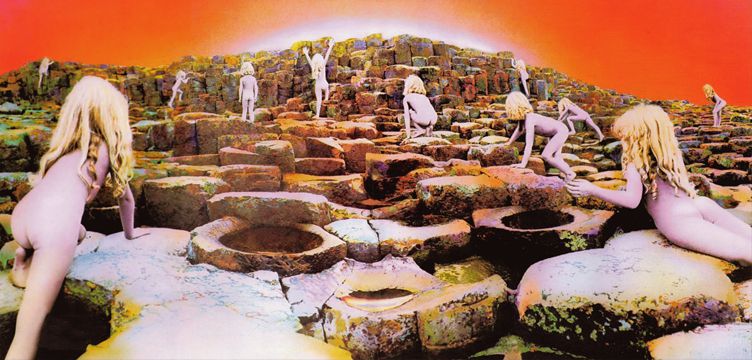
In The Courtroom Of The Crimson Rex (Rex Cerise)
In The Courtroom Of The Carmine King'due south surrealistic, gothic encompass art was created by a estimator developer named Barry Godber, who died before long after the album's release. The iconic artwork consists of a vivid-ruddy screaming face up of a schizoid homo, making a reference to the album's get-go runway – "21st Century Schizoid Man".
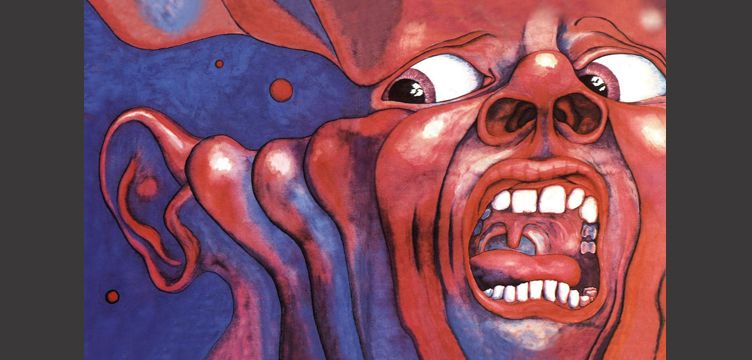
London Calling (The Clash)
Probably the most iconic encompass art in the history of punk rock, London Calling artwork was actually intended by Ray Lowry to pay homage to the design of Elvis Presley'southward debut album. The picture of Paul Simon smashing his Fender Precision Bass has been immortalized in the Rock and Roll Hall of Fame Museum.
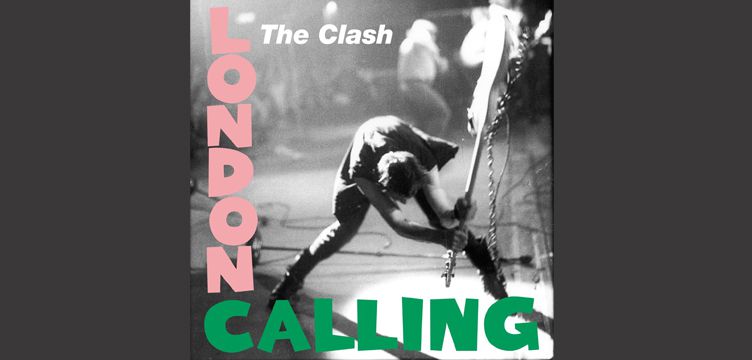
Motörhead (Motörhead)
One of the most influential artworks in heavy metal, this cover art – featuring the famous War-Pig (also known as Snaggletooth or The Little Bastard) – was designed by Joe Petagno of Hipgnosis. Petagno came up with this fascinating mascot afterward studying skulls of wild boars, gorillas and dogs.
The gothic-style lettering, with the umlaut graphic symbol ö, was created by English designer Phil Smee.
Never Mind the Bollocks, Hither's the Sex Pistols (Sexual practice Pistols)
Never Mind the Bollocks, Hither's the Sex Pistols front cover features the famous ransom-notation cutout lettering and an exuberant pink and acidic yellow colour anarchic-style theme.
Designed by English creative person and anarchist Jamie Reid, who intended information technology as an antithesis of a conventional professional design, it is probably the near imitated and influential artwork in punk rock.

Nevermind (Nirvana)
Nevermind album sleeve was designed by Robert Fisher, then-art director at Geffen Records. It featured a circumcised, three-month-old male person baby pond underwater and chasing a US dollar pecker on a fishhook.
Kurt Cobain came up with the idea later on watching a television program on water births. He mentioned it to Fischer who selected his friend's babe son, Spencer Elden, for the shoot.
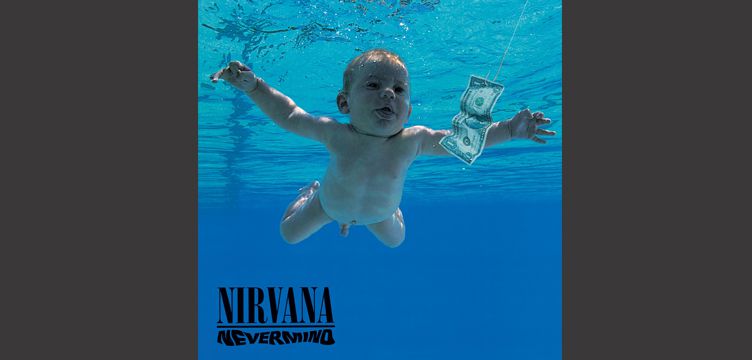
Physical Graffiti (Led Zeppelin)
One of the almost acclaimed album covers in archetype rock, the aptly-titled double album shows a façade of an elegant New York apartment located at 97 Saint Marks Place in East Village.
Jimmy Page mentioned in an interview that he came upward with the album title and sleeve'southward concept and intended information technology as a "physical argument rather than a written one". Information technology was designed by British visual artists Mike Doud and Peter Corriston.
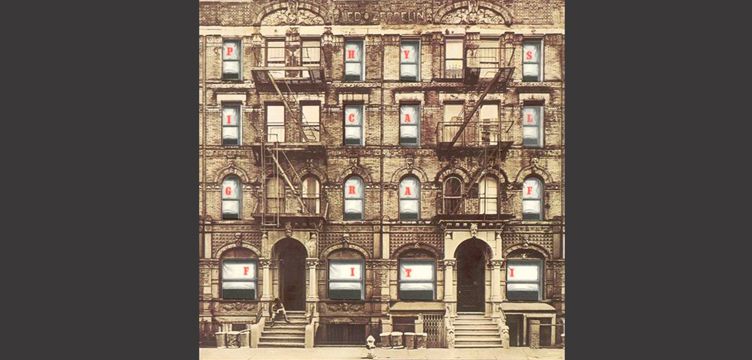
Remain in Lite (Talking Heads)
The now-iconic Remain in Light cover was conceptualized by bassist Tina Weymouth and drummer Chris Frantz, and designed in collaboration with Massachusetts Institute of Technology Professor Walter Bender and his MIT Media Lab team.
The first album embrace in history to feature computer graphics, it shows carmine masks over each band member's confront. The rest of the artwork and the liner notes were provided by Tibor Kalman, one of America's greatest graphic designers ever.
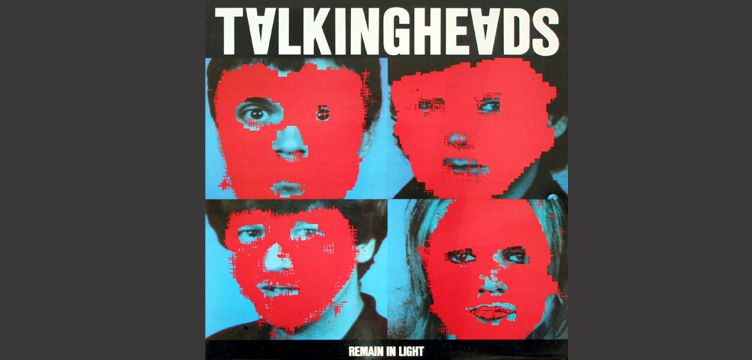
Rumours (Fleetwood Mac)
Based on a stylized version of rock photographer Herbert Worthington's photo, Rumours' anthology sleeve features Mick Fleetwood in a black velvet outfit with a pair of wooden balls suspended from a cord, and Stevie Nicks dressed upwards in her now-legendary "Rhiannon" stage persona.
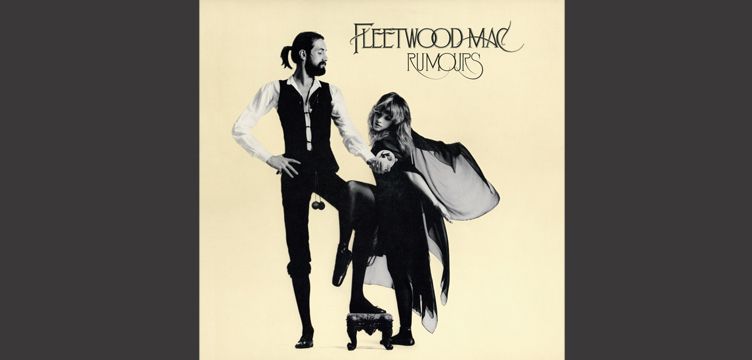
Sgt. Pepper's Solitary Hearts Club Ring (The Beatles)
Probably the almost memorable comprehend artwork e'er created, Sgt. Pepper's album sleeve depicts the four Beatles photographed in forepart of a collage of famous historical figures, sporting a psychedelic, mustached await.
Based on an ink cartoon by Paul McCartney, information technology was designed by Peter Blake and Jann Haworth. Photographed by Michael Cooper, fine art direction for the comprehend was provided by Robert Fraser. The artwork, on which the band reportedly spent more than than $five,500, gained controversy for its explicit display of marijuana plants and cryptic collection of personalities.
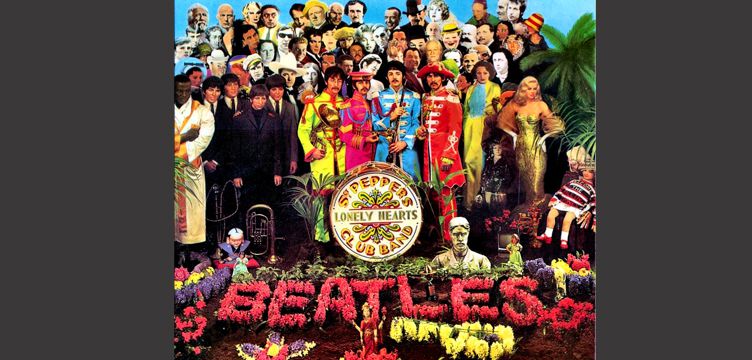
Glutinous Fingers (The Rolling Stones)
Originally conceived by Andy Warhol, photographed by Billy Name and designed past Craig Braun, Gluey Fingers' album cover features a sexual innuendo: a human'due south "messy" crotch in a pair of jeans, with an actual working pants zipper.
Several male models were photographed for the project, amidst them Warhol's boyfriend Jed Johnson and Warhol superstar Joe Dallesandro.
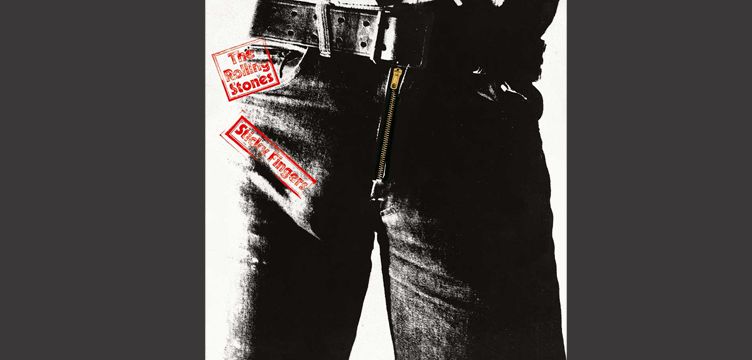
The Dark Side Of The Moon (Pinkish Floyd)
A deliberate endeavor to avoid the traditional pictorial imagery, the refracting prism splitting a beam of light smartly depicts the conceptual ability of the Pink Floyd's lyrics as well equally the ring'due south famous stage lighting effects.
Drawn past George Hardie and based on a photo taken by Storm Thorgerson of Hipgnosis, it is undoubtedly one of the most iconic anthology covers e'er created.

The Doors (The Doors)
The psychedelic cover art of the ring's self-titled debut album is credited to Bill Harvey of Elektra Records. It features the band members of The Doors and on top, a advisedly constructed and functionally precise, geometrical wordmark that afterward become i of the most iconic rock band logos in history.
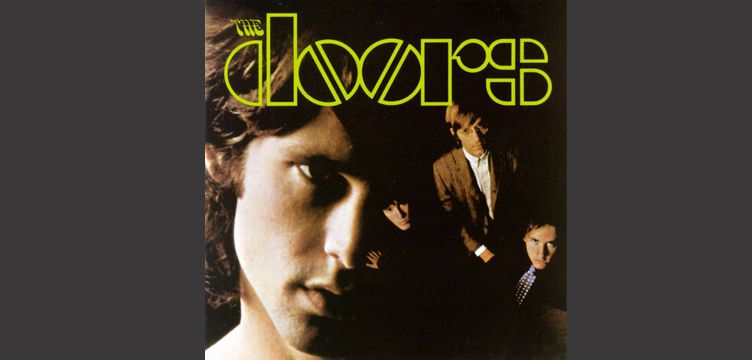
The Kids Are All Right (The Who)
The anthology sleeve for The Who'south soundtrack to the 1979 documentary of the same name was based on a Fine art Kane photograph, which was taken at the Carl Schurz Monument in Morningside Heights, New York City.
The group, draped under a Union Jack flag, is sleeping against a wall. Carl Schurz was a German language-American political leader and revolutionary who became the first German-born American elected to the United States Senate in 1896.
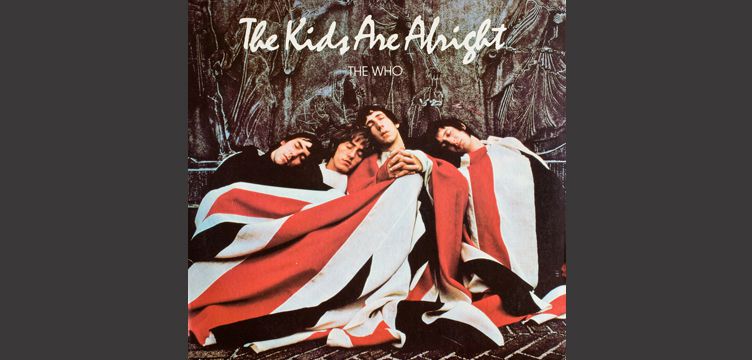
The Velvet Underground & Nico (The Velvet Underground)
Arguably the most memorable album cover ever created, The Velvet Underground & Nico – also known as the banana album – sported Andy Warhol's phallic pare-off-banana artwork with minimal typography and clean blueprint. The early copies of the album allowed the owner to peel back the assistant skin as a sticker.
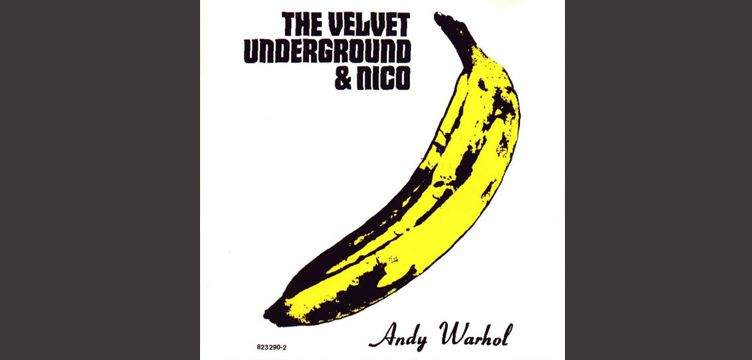
The White Album (The Beatles)
The cover jacket of the White Album, comprising of a white foursquare with the ring'due south name displayed slightly off center and a unique stamped serial number, was designed by pop art pioneer Richard Hamilton. His "uncluttered" design arroyo was in a dramatic contrast with Peter Blake'due south colorful artwork for Sgt. Pepper's Lone Hearts Club Ring.

War (U2)
The picayune boy appearing on the War forepart encompass was a 9-year-quondam Peter Rowen, the younger blood brother of Bono'due south shut friend Guggi. Rowen, now a 41-year-quondam photographer based in Dublin, Ireland, also appeared on the artworks of Three (1979) and Boy (1970).

Where to acquire more
- 100 Best Anthology Covers by Tempest Thorgerson
- Rock Art: The Golden Historic period of Record Album Covers past Dennis Saleh
- The Stories Behind the Rolling Stones' Mucilaginous Fingers and 4 Other Famous Stone Covers
- The Well-nigh Iconic Clothing in Pop Music Illustration Series
edmondonlaceing1982.blogspot.com
Source: https://speckyboy.com/memorable-album-covers-rock-era/
0 Response to "Joe Petagno Art of Elvis Epereguspat7 Tm Off"
Post a Comment